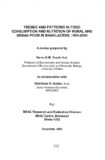| dc.description.abstract | A review report is prepared on the trends and patterns of food intake and
nutritional status of the poor rural and urban households of Bangladesh during
the decade of 1991-2000. Because agricultural production is the main
determinant of the quantity and quality of meals in a poor agrarian country like
Bangladesh, a thorough review of trends in gross production and gross per
capita availability of commonly consumed foods was first made. The decade is
marked by a commendable increase in food production, particularly rice during
the second half of the decade, along with other food items like wheat, potato,
vegetables, fish, meat and milk. This made the average national diet of the year
2000 richer in terms of quantity (892 g/capita/day), energy (2,112) Kcal and
protein (53 g) compared to the diet of all previous survey years. However, the
country is yet to acieve the desirable requirement level in any terms: the diet is
still highly imbalanced, with rice and other cereals contributing nearly 80% of
total energy and fruits and vegetables contributing only 3%. The diet is thus
deficient in vitamins and minerals. The decade of 1991-2000 is marked by a commendable economic growth, with
concomitant decline in the incidence of both absolute poverty and extreme
poverty, by 9 percentage points each, more in urban than in rural areas,
although the rate of decline in urban poverty slowed down in the latter years of
the decade. However, in 2000, the incidence of absolute poverty was still 50%
and the incidence of extreme poverty was 34%. In absolute terms, during the
decade, the number of poor in rural areas decreased from 58 million to 42
million, while the number of poor in urban areas showed an appalling 100%
increase from 7 million to 15 million.
Since food distribution inequity is heavily weighted on the poor, the food intake
of the poor in both rural and urban areas, remained inadequate in quantity
(around 700 g/day), energy (1790 Kcal, 25% less than the requirement) as well
as in protein (40 g/day, 30% less than required). Their diet is also precariously
imbalanced, nearly 90% energy coming from cereals, 85% from rice alone, an
inevitable consequence of which is malnutrition. Analysis shows that between
1991-2000, no improvement had occurred in the quantity nor in the quality of
the diet of the poor and the poorest (bottom 40% expenditure category). This is
true for both rural and urban areas. The urban slums are even worse.
In poor households of both rural and urban areas, allocation of household
expenditure for food is 70%. So, more than two-thirds of the income is spent for
food which is inadequate in quantity and quality. Needless to say, the remaining
30% can barely meet the other necessities of life. Market dependence is very
high in the rural areas, where nearly one-quarter of major foods like rice,
vegetables and fish are procured from own production and the remainder is
purchased from the market. Only in case of egg, the proportion of own production in both poor and rich households is 32-54%, indicating traditional
poultry raising in rural areas.
Parallel with national average economic growth, poverty reduction, increased
food production and food intake. Bangladesh has achieved a commendable
reduction in child malnutrition rates during the nineties. Night blindness due to
vitamin A deficiency in children under 6 years of age decreased to almost nonexistence
levels (0.3%) during the decade. But despite these improvements.
50% of preschool children were still stunted or underweight. 18-19% severely.
in 2000. Percentage of malnourished children coming from poor families is even
higher. over 60%. The prevalence is higher in rural than in urban areas and girls
are more affected than boys. Over 50% children are anaemic.
Chronic energy deficiency (CED) prevalence in women of child bearing age has
also decreased over the years of the decade. but still. 45% of rural and 35% of
urban (slum) mothers suffer from CED. Still. about half of all pregnant mothers
are anaemic.
Infant feeding practice (colostrum and breast milk as first food after birth and
start of complementary feeding with right type of food at the right time, i.e. 5
months of age or later) are found to have strong bearing on child's nutritional
status. Enriching the family food, which becomes more and more important in
the infant's diet, may be enriched with egg, fish, pulse and oil. Appalling is the
finding that 65% of poor families do not eat egg at all, even though they have
egg in the house: they save it for hatching or sell it for hard cash.
Thus, poor households, rural and urban alike, did not get the benefit of
increased food production and the economic growth that the country has
achieved during the nineties: in year 2000, their food intake was low and their
food was imbalanced , as it was in year 1991. Those who have come out of
poverty are lucky, but more pro-poor action programmes need to be taken to
bring more poor out of poverty, and sooner the better. | en_US |

